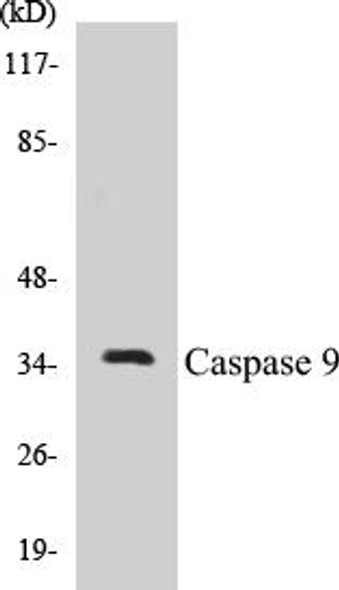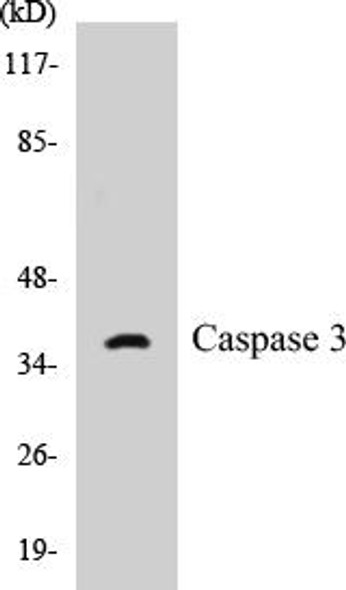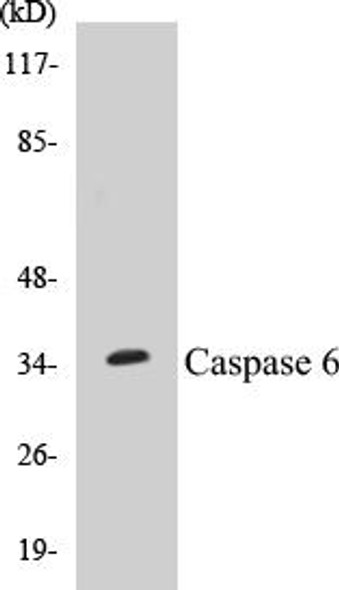Caspase 10 Colorimetric Cell-Based ELISA Kit (CBCAB00563)
- SKU:
- CBCAB00563
- Product Type:
- ELISA Kit
- ELISA Type:
- Cell Based
- Research Area:
- Cell Death
- Reactivity:
- Human
- Detection Method:
- Colorimetric
Description
Caspase 10 Colorimetric Cell-Based ELISA Kit
The Caspase-10 Colorimetric Cell-Based ELISA Kit from Assay Genie is a powerful tool for researchers looking to study cell apoptosis and signaling pathways. This kit is specifically designed for the accurate detection of caspase-10 levels in cell lysates, offering high sensitivity and specificity for reliable and reproducible results.Caspase-10 is a key player in the apoptosis pathway, playing a critical role in regulating cell death and survival. Dysregulation of caspase-10 has been implicated in various diseases, including cancer, autoimmune disorders, and neurodegenerative diseases.
By accurately measuring caspase-10 levels, researchers can gain valuable insights into the mechanisms underlying these diseases and identify potential therapeutic targets.The Caspase-10 Colorimetric Cell-Based ELISA Kit offers convenience and efficiency, allowing researchers to easily quantify caspase-10 levels in a wide range of cell types and conditions. With its user-friendly protocol and robust performance, this kit is a valuable tool for advancing research in apoptosis, cell signaling, and disease biology.
| Product Name: | Caspase 10 Colorimetric Cell-Based ELISA |
| Product Code: | CBCAB00563 |
| ELISA Type: | Cell-Based |
| Target: | Caspase 10 |
| Reactivity: | Human |
| Dynamic Range: | > 5000 Cells |
| Detection Method: | Colorimetric 450 nmStorage/Stability:4°C/6 Months |
| Format: | 96-Well Microplate |
The Caspase 10 Colorimetric Cell-Based ELISA Kit is a convenient, lysate-free, high throughput and sensitive assay kit that can detect Caspase 10 protein expression profile in cells. The kit can be used for measuring the relative amounts of Caspase 10 in cultured cells as well as screening for the effects that various treatments, inhibitors (ie siRNA or chemicals), or activators have on Caspase 10.
Qualitative determination of Caspase 10 concentration is achieved by an indirect ELISA format. In essence, Caspase 10 is captured by Caspase 10-specific primary antibodies while the HRP-conjugated secondary antibodies bind the Fc region of the primary antibody. Through this binding, the HRP enzyme conjugated to the secondary antibody can catalyze a colorimetric reaction upon substrate addition. Due to the qualitative nature of the Cell-Based ELISA, multiple normalization methods are needed:
| 1. | A monoclonal antibody specific for human GAPDH is included to serve as an internal positive control in normalizing the target absorbance values. |
| 2. | Following the colorimetric measurement of HRP activity via substrate addition, the Crystal Violet whole-cell staining method may be used to determine cell density. After staining, the results can be analysed by normalizing the absorbance values to cell amounts, by which the plating difference can be adjusted. |
| Database Information: | Gene ID: 843, UniProt ID: Q92851-2/4, OMIM: 601762, Unigene: Hs.5353 |
| Gene Symbol: | CASP10 |
| Sub Type: | None |
| UniProt Protein Function: | CASP10: Involved in the activation cascade of caspases responsible for apoptosis execution. Recruited to both Fas- and TNFR-1 receptors in a FADD dependent manner. May participate in the granzyme B apoptotic pathways. Cleaves and activates caspase- 3, -4, -6, -7, -8, and -9. Hydrolyzes the small- molecule substrates, Tyr-Val-Ala-Asp-|-AMC and Asp-Glu-Val-Asp-|-AMC. Heterotetramer that consists of two anti-parallel arranged heterodimers, each one formed by a 23/17 kDa (p23/17) (depending on the splicing events) and a 12 kDa (p12) subunit. Self-associates. Interacts with FADD and CASP8. Found in a Fas signaling complex consisting of FAS, FADD, CASP8 and CASP10. Detectable in most tissues. Lowest expression is seen in brain, kidney, prostate, testis and colon. Belongs to the peptidase C14A family. 6 isoforms of the human protein are produced by alternative splicing. Protein type: EC 3.4.22.63; Protease Chromosomal Location of Human Ortholog: 2q33-q34 Cellular Component: cytoplasm; plasma membrane; CD95 death-inducing signaling complex; cytosol Molecular Function: protein binding; cysteine-type endopeptidase activity; ubiquitin protein ligase binding Biological Process: regulation of apoptosis; positive regulation of I-kappaB kinase/NF-kappaB cascade; apoptosis; innate immune response; proteolysis Disease: Lymphoma, Non-hodgkin, Familial; Gastric Cancer; Autoimmune Lymphoproliferative Syndrome, Type Iia |
| UniProt Protein Details: | |
| NCBI Summary: | This gene encodes a protein which is a member of the cysteine-aspartic acid protease (caspase) family. Sequential activation of caspases plays a central role in the execution-phase of cell apoptosis. Caspases exist as inactive proenzymes which undergo proteolytic processing at conserved aspartic residues to produce two subunits, large and small, that dimerize to form the active enzyme. This protein cleaves and activates caspases 3 and 7, and the protein itself is processed by caspase 8. Mutations in this gene are associated with type IIA autoimmune lymphoproliferative syndrome, non-Hodgkin lymphoma and gastric cancer. Alternatively spliced transcript variants encoding different isoforms have been described for this gene. [provided by RefSeq, Apr 2011] |
| UniProt Code: | Q92851-2 |
| NCBI GenInfo Identifier: | 12644463 |
| NCBI Gene ID: | 843 |
| NCBI Accession: | Q92851.3 |
| UniProt Secondary Accession: | Q92851-2,Q68HC0, Q6KF62, Q6KF63, Q8IUP5, Q8WYQ8, Q99845 Q9Y2U6, Q9Y2U7 |
| UniProt Related Accession: | Q92851-2,Q92851 |
| Molecular Weight: | 59kDa |
| NCBI Full Name: | Caspase-10 |
| NCBI Synonym Full Names: | caspase 10, apoptosis-related cysteine peptidase |
| NCBI Official Symbol: | CASP10 |
| NCBI Official Synonym Symbols: | MCH4; ALPS2; FLICE2 |
| NCBI Protein Information: | caspase-10; CASP-10; FADD-like ICE2; apoptotic protease MCH-4; ICE-like apoptotic protease 4; interleukin-1B-converting enzyme 2; caspase 10, apoptosis-related cysteine protease; FAS-associated death domain protein interleukin-1B-converting enzyme 2 |
| UniProt Protein Name: | Caspase-10 |
| UniProt Synonym Protein Names: | Apoptotic protease Mch-4; FAS-associated death domain protein interleukin-1B-converting enzyme 2; FLICE2; ICE-like apoptotic protease 4Cleaved into the following 2 chains:Caspase-10 subunit p23/17; Caspase-10 subunit p12 |
| Protein Family: | Caspase |
| UniProt Gene Name: | CASP10 |
| UniProt Entry Name: | CASPA_HUMAN |
| Component | Quantity |
| 96-Well Cell Culture Clear-Bottom Microplate | 2 plates |
| 10X TBS | 24 mL |
| Quenching Buffer | 24 mL |
| Blocking Buffer | 50 mL |
| 15X Wash Buffer | 50 mL |
| Primary Antibody Diluent | 12 mL |
| 100x Anti-Phospho Target Antibody | 60 µL |
| 100x Anti-Target Antibody | 60 µL |
| Anti-GAPDH Antibody | 60 µL |
| HRP-Conjugated Anti-Rabbit IgG Antibody | 12 mL |
| HRP-Conjugated Anti-Mouse IgG Antibody | 12 mL |
| SDS Solution | 12 mL |
| Stop Solution | 24 mL |
| Ready-to-Use Substrate | 12 mL |
| Crystal Violet Solution | 12 mL |
| Adhesive Plate Seals | 2 seals |
The following materials and/or equipment are NOT provided in this kit but are necessary to successfully conduct the experiment:
- Microplate reader able to measure absorbance at 450 nm and/or 595 nm for Crystal Violet Cell Staining (Optional)
- Micropipettes with capability of measuring volumes ranging from 1 µL to 1 ml
- 37% formaldehyde (Sigma Cat# F-8775) or formaldehyde from other sources
- Squirt bottle, manifold dispenser, multichannel pipette reservoir or automated microplate washer
- Graph paper or computer software capable of generating or displaying logarithmic functions
- Absorbent papers or vacuum aspirator
- Test tubes or microfuge tubes capable of storing ≥1 ml
- Poly-L-Lysine (Sigma Cat# P4832 for suspension cells)
- Orbital shaker (optional)
- Deionized or sterile water
*Note: Protocols are specific to each batch/lot. For the correct instructions please follow the protocol included in your kit.
| Step | Procedure |
| 1. | Seed 200 µL of 20,000 adherent cells in culture medium in each well of a 96-well plate. The plates included in the kit are sterile and treated for cell culture. For suspension cells and loosely attached cells, coat the plates with 100 µL of 10 µg/ml Poly-L-Lysine (not included) to each well of a 96-well plate for 30 minutes at 37°C prior to adding cells. |
| 2. | Incubate the cells for overnight at 37°C, 5% CO2. |
| 3. | Treat the cells as desired. |
| 4. | Remove the cell culture medium and rinse with 200 µL of 1x TBS, twice. |
| 5. | Fix the cells by incubating with 100 µL of Fixing Solution for 20 minutes at room temperature. The 4% formaldehyde is used for adherent cells and 8% formaldehyde is used for suspension cells and loosely attached cells. |
| 6. | Remove the Fixing Solution and wash the plate 3 times with 200 µL 1x Wash Buffer for five minutes each time with gentle shaking on the orbital shaker. The plate can be stored at 4°C for a week. |
| 7. | Add 100 µL of Quenching Buffer and incubate for 20 minutes at room temperature. |
| 8. | Wash the plate 3 times with 1x Wash Buffer for 5 minutes each time. |
| 9. | Add 200 µL of Blocking Buffer and incubate for 1 hour at room temperature. |
| 10. | Wash 3 times with 200 µL of 1x Wash Buffer for 5 minutes each time. |
| 11. | Add 50 µL of 1x primary antibodies (Anti-Caspase 10 Antibody and/or Anti-GAPDH Antibody) to the corresponding wells, cover with Parafilm and incubate for 16 hours (overnight) at 4°C. If the target expression is known to be high, incubate for 2 hours at room temperature. |
| 12. | Wash 3 times with 200 µL of 1x Wash Buffer for 5 minutes each time. |
| 13. | Add 50 µL of 1x secondary antibodies (HRP-Conjugated AntiRabbit IgG Antibody or HRP-Conjugated Anti-Mouse IgG Antibody) to corresponding wells and incubate for 1.5 hours at room temperature. |
| 14. | Wash 3 times with 200 µL of 1x Wash Buffer for 5 minutes each time. |
| 15. | Add 50 µL of Ready-to-Use Substrate to each well and incubate for 30 minutes at room temperature in the dark. |
| 16. | Add 50 µL of Stop Solution to each well and read OD at 450 nm immediately using the microplate reader. |
(Additional Crystal Violet staining may be performed if desired – details of this may be found in the kit technical manual.)






